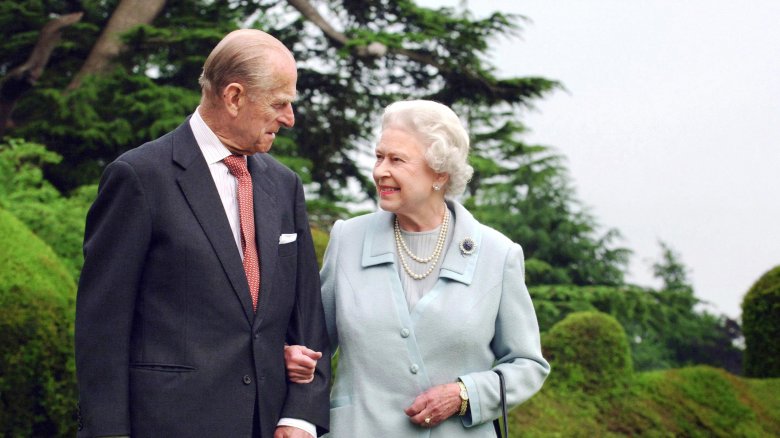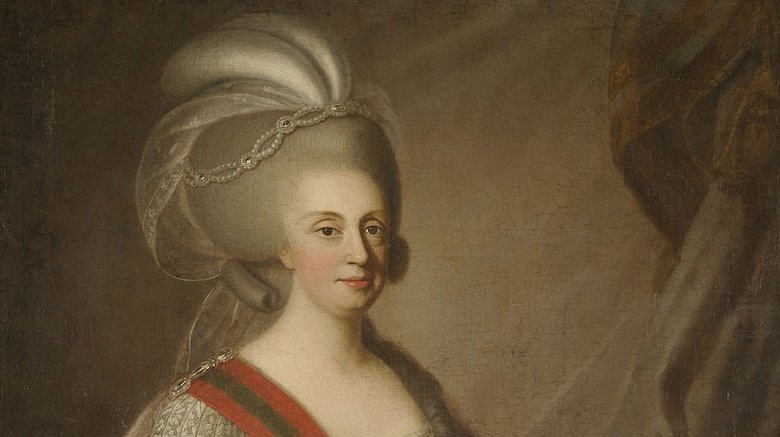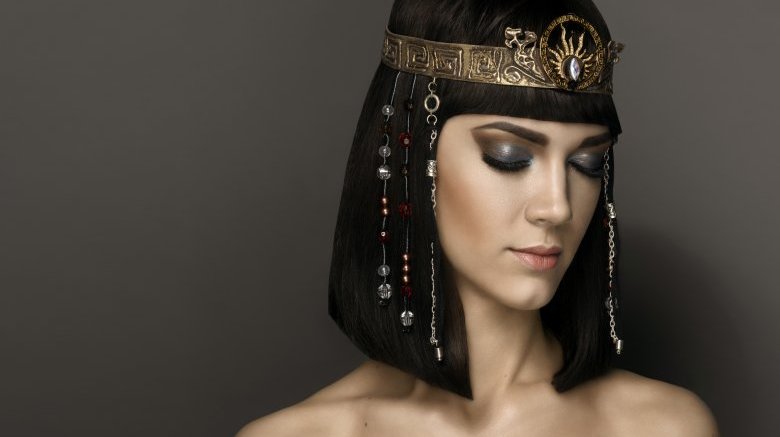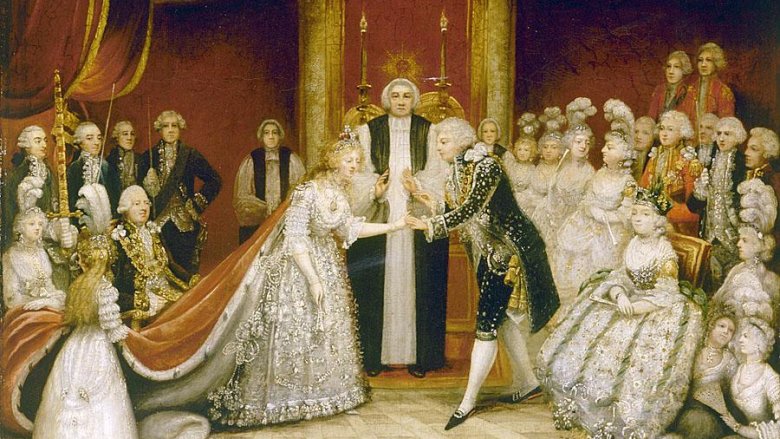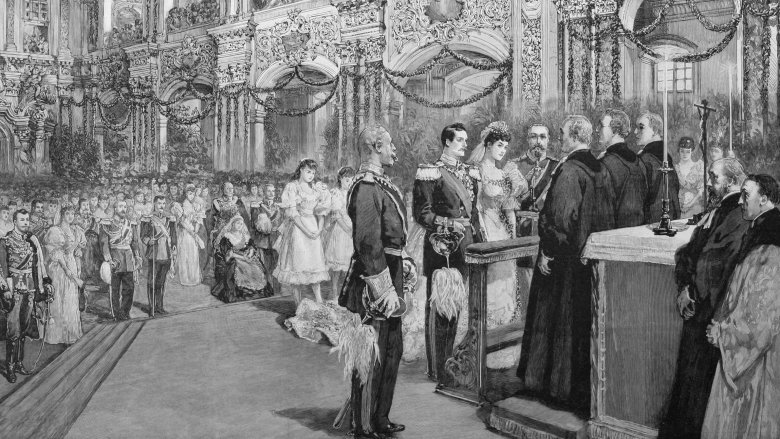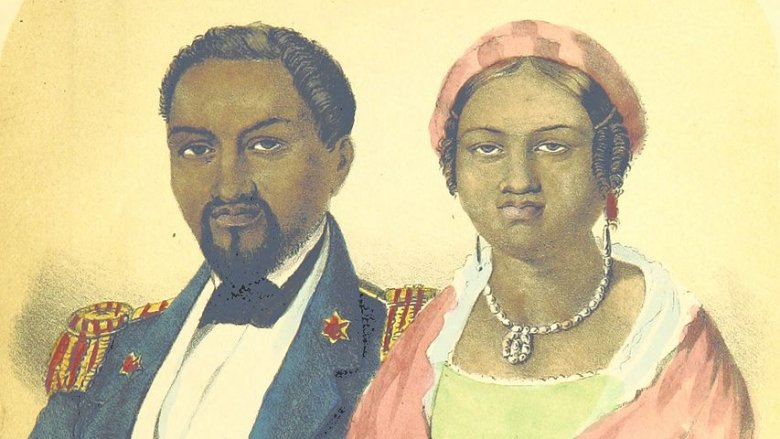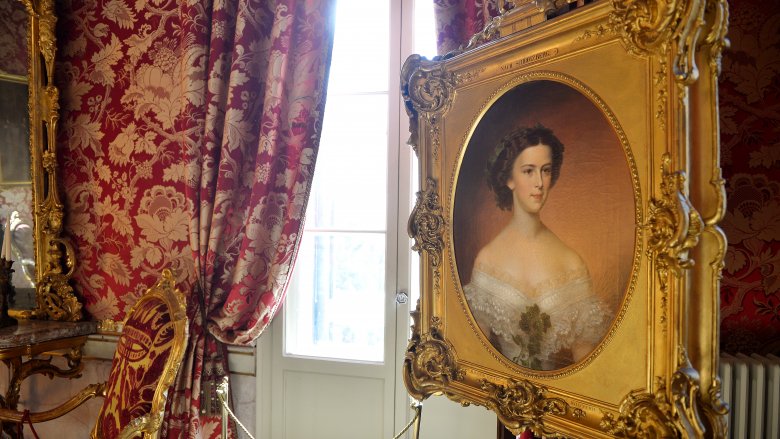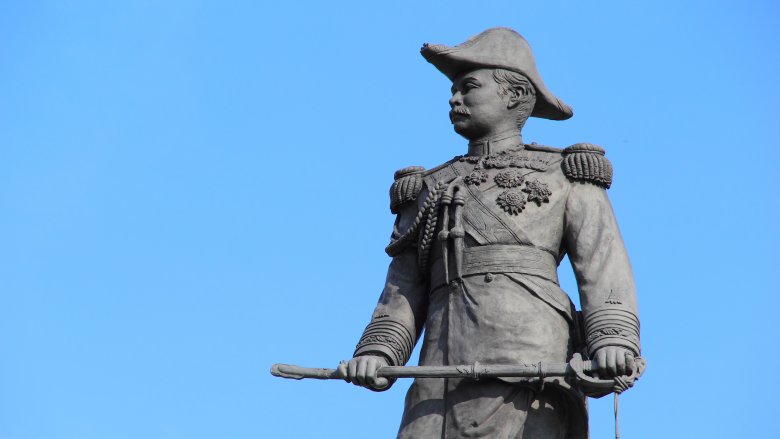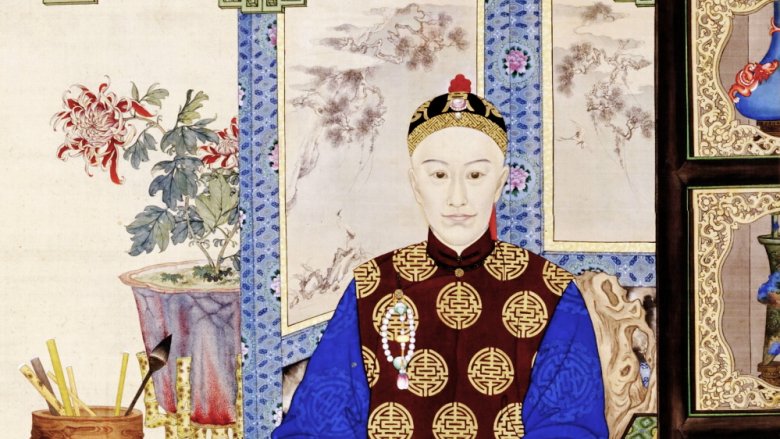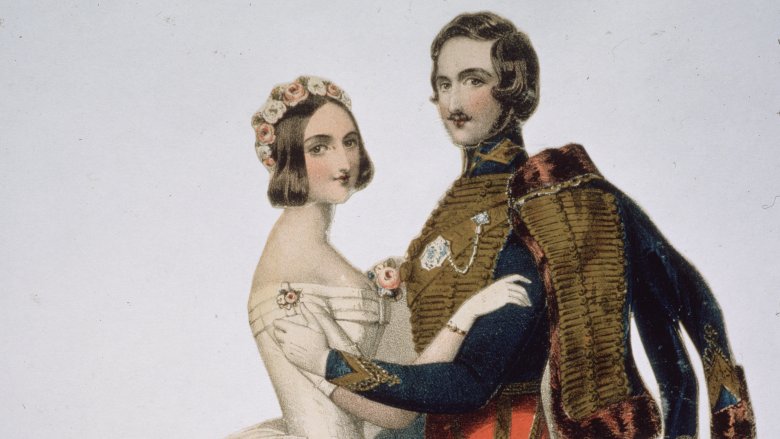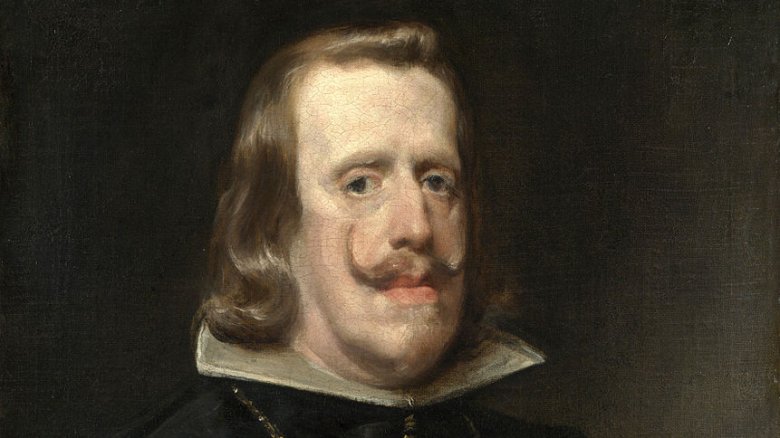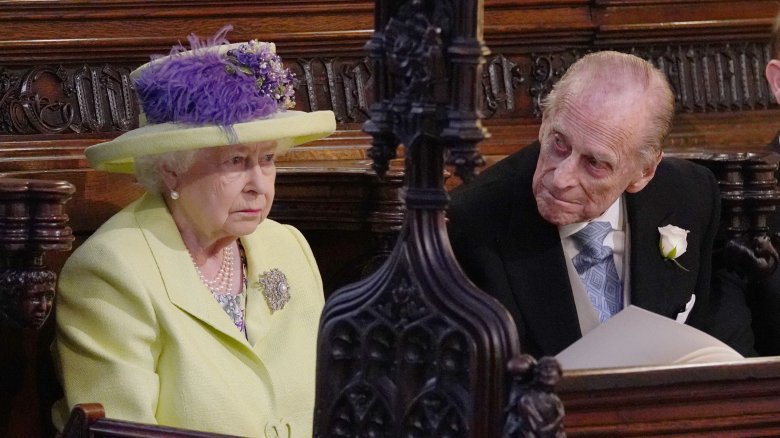Royals Who Married Their Relatives
Historically, the rules of royal marriages have been completely bizarre to normal people. Marrying for love, or even with a tiny bit of choice, was almost always out of the question. Royal marriages were arranged as part of treaties or to consolidate power. This meant it wasn't unusual for very young children to get coupled up. It also meant those couples were often made up of people who were related — often with a degree of closeness that seems disturbing, if not outright illegal, today.
But that was the way things were done. It made sense to everyone at the time. Of course, we now know that inbreeding leads to serious problems, which explains why some royal houses are famous for madness and ugliness to the point of deformity. And that doesn't even begin to address the relationship problems that usually come with arranging these marriages to begin with. Royal inbreeding was, on the whole, a disaster.
Maria I loved one guy, her uncle and husband
The Portuguese royal family was known for inbreeding and going mad, so Maria carried on the illustrious tradition by marrying her uncle and then going nuts.
According to Mad Monarchs, Maria was a devout child who wanted to become a nun. But History of Royal Women tells us that with all her brothers dead, Maria was her father's heir, so she had to get married. A Spanish uncle was considered, but there was a weird rule that to be queen one day she had to marry someone from her own country. Since she also needed to marry someone royal, this basically meant Maria had to marry a relative. So in 1760, she married a different uncle, Pedro, her father's younger brother. He was 17 years older than his niece-bride.
Amazingly, despite the arranged marriage and the age difference, they adored each other. The couple had the same hobbies, namely, going to church a million times a day. They also had seven children together, although many of them died young (probably helped along by the incest). Maria had already started acting weird before Pedro died in 1786. They were devoted to each other to the end and his death was unbelievably painful for her, solidifying her descent into madness. Maria was declared officially insane in 1792. The tradition of ridiculous incest was carried on when Maria's son was married to her sister, his aunt, making that couple related in so many confusing ways. Fortunately, they didn't have kids.
Cleopatra went to war against her brother-husband
Cleopatra had three men in her life, and all of them were used to shore up her power in one way or another. While her relationships with non-relatives Julius Caesar and Mark Antony are the most famous, her first marriage was actually to her brother.
The most famous Egyptian queen was the last in a long line of ethnically Greek rulers called the Ptolemies. In order to keep power within the family, it was normal for that dynasty to marry relatives, often brothers and sisters. According to Live Science, when Cleopatra's dad, Ptolemy XII, died in 55 B.C., his will ordered her to marry her 10-year-old brother and share the throne with him.
Even though they wed, the siblings never had any sort of physical relationship. In fact, Ptolemy XIII and his advisers refused to acknowledge her as co-ruler, and Cleopatra was forced to flee. When Julius Caesar arrived in Egypt three years later, Ptolemy refused to let Cleopatra see him. (This is where the whole rolled-up carpet story comes from.) However she managed it, Cleopatra snuck into Caesar's rooms and pleaded her case. By the next morning, he was on her side. The 13-year-old ruler threw a fit and it looked like people might riot, but Caesar read out their dad's will, proving they were supposed to rule together. Cleopatra's brother-husband would end up dying in a failed rebellion, while she went on to enjoy a fortunately not-at-all incestuous relationship with Mark Antony.
King George IV proved keeping it in the family can be a disaster
When George IV, then Prince of Wales, met his first cousin and fiancé Caroline of Brunswick for the first time in 1795, he was so repulsed that he asked for a stiff drink. Caroline, for her part, complained that the fat prince didn't look anything like the handsome portraits she'd seen, according to History Answers. The cousins' union was always going to be a disaster. George had already been married for 10 years to the commoner Maria Fitzherbert. They even had two kids. But that marriage didn't count because she was a Catholic. George's debts started getting out of control, but the only way Parliament would pay them was if he got married properly. So Caroline it was.
To get through the wedding ceremony, the prince was fall-down drunk. Amazingly, that night he managed to get his new wife pregnant. It would be the only time they had sex. Both of them openly started cheating on the other, and within two years they had officially separated.
But George wanted rid of this woman forever. He even brought her to court when she adopted a baby boy, making the prime minister find out if the kid was actually Caroline's secret baby by a footman. When George was crowned king, she should have been crowned queen beside him, but George had the doors locked in her face. And when an official informed him of Napoleon's death, saying, "Sire, your greatest enemy is dead," George replied, in all seriousness, "Is she, by God?"
Princess Victoria Melita married one cousin by force, one by choice
Princess Victoria Melita was known in her family as Ducky because it was hard to keep the approximately 8 million Victorias straight. Ethnically British, German, and Russian through her parents, she was a relatively minor royal, but her marriage was still strictly controlled. As a girl, Ducky traveled to Russia and fell in love with her first cousin Cyril Vladimirovich Romanov, according to History Extra. He returned her feelings. But Ducky's grandmother Queen Victoria was in charge of who she married, and the queen wanted someone closer to home. Instead, her grandma picked a different first cousin, Grand Duke Ernest of Hesse (now part of Germany).
The marriage was a disaster from day one. Ernest was described a "reluctant bridegroom," possibly because he was gay and absolutely everyone knew it. And Ducky was still pining for her Russian cousin. The couple managed to have a daughter within a year, but Ducky already wanted out. Miserable and lonely in her marriage, she asked Queen Victoria if she could get a divorce but was denied, as divorce was unthinkable to the queen. But after her grandmother died in 1901, Ducky got divorced anyway, and it scandalized Europe.
The princess wasn't done getting hitched to first cousins. Still in love, Ducky and Cyril married, but without the tsar's permission, which they needed as members of his family. He retaliated by banning them from Russia. He came around years later, but the kissing cousins spent the beginning of their marriage in exile.
Kamehameha III wasn't gonna listen to some missionaries
Incest was not an acceptable practice for regular Hawaiians, but it was a privilege for the ruling class. According to a historical journal, marrying a close female relative was considered extremely important for a high chief or king. The closer the better, which resulted in many brother-sister unions. These were considered "the most perfect and revered" and given the utmost respect. Any children born to a brother and sister coupling were considered divine.
Some historians believe Kamehameha and his sister Nahi'ena'ena had slept together by the time she was 9. Three years later, in 1827, news of their physical relationship made it to the Christian missionaries on the island, and they were not happy. Royal Foibles says it got even worse in 1832, when Kamehameha (pictured later in life with a different wife) came of age and officially took the throne. One of his first acts was to announce he was marrying his sister. The missionaries were absolutely not having that and tried to persuade him to end their relationship. While outwardly he pretended to be convinced and both Kamehameha and Nahi'ena'ena got engaged to people more acceptable to the priests, in reality they married in secret and continued sleeping together.
Nahi'ena'ena publicly married the guy the missionaries wanted her to, but Encyclopedia Britannica tells us that by then she was already pregnant with her brother's child. Kamehameha openly acknowledged the kid as his and said it would be his heir. But the baby died within hours of being born, and the mother followed only a few months later.
Empress Elisabeth couldn't stand her kissing cousin
Empress Elisabeth of Austria and Hungary, famously known as Sisi, wasn't originally the selection to marry the young emperor Franz Joseph. His mother, Sophie, demanded he marry one of her sister's daughter's, his first cousins, and in 1853 sent him to meet the one she had picked out. But the girl had been accompanied by her younger sister Sisi. She was only 15, but Franz fell head over heels in love with her, totally ignoring the sister he was there to meet. According to World of the Habsburgs, Franz informed his mother if he couldn't marry the first cousin he'd chosen, he wouldn't get married at all. He got his way.
For a marriage that started with such a sweet story, it went wrong from the beginning. Sisi could barely tolerate her husband, even though (or perhaps because) his love for her "bordered on infatuation." She didn't try to hide it either, with Franz once writing her, "Even though you were very cruel and vexing, I love you so boundlessly that I cannot be without you." Sisi demanded they have separate bedrooms, which was normal for most royals but an extremely unusual arrangement in Vienna. She often went on months-long vacations, always staying away until her husband finally demanded she come home. Sisi would use Franz's affection to her advantage, threatening to divorce him unless she got her way on things.
Not that Franz was perfect. He was notorious for his womanizing and may have given Sisi an STD he got while sleeping around.
King Chulalongkorn didn't stop at just one sister
Chulalongkorn became king of Siam (now Thailand) in 1868 when he was just 15 years old. (If being king of Siam rings a bell, yes, he was the favorite son and heir of the eponymous king in The King and I.) According to the book A Kingdom in Crisis, over the course of his reign Chulalongkorn would rack up 153 wives and concubines. But the most important by far were his four half-sisters.
Incest was practiced by the Thai royal family for centuries. There was a cult of belief that said the more royal blood you had, the more important you were. This meant if a king wanted his kids to have the most royal blood possible, he had to have them with his female cousins, or aunts, or sisters. And even among those incestuous relationships, there was a hierarchy. Having kids with his sisters meant lots of super-royal children. Any children he had with non-family members would have diluted fancy blood.
The British officials in the country were really not okay with all the incest and polygamy. They pointed to the practices as proof of Thailand's "backwardness."
Unrelated to her marriage, one of the sister-wives met a sad end. In 1880, her royal barge capsized. There were "numerous bystanders" who could have saved her, except for a rule that no one could touch royals, ever, or else they and their whole family would be killed. That meant a bunch of people stood and watched as the queen drowned.
The Guangxu Emperor preferred his concubine to his cousin
The tenth Qing emperor, also known as Zaitian, wasn't meant to rule. But his cousin died young without children and in 1875 he was selected as the next ruler by the powerful dowager empress, his aunt Cixi. She would remain an absolutely domineering presence in his life, even though technically he was in charge.
Cixi was not going to let her nephew pick his own wife. And she wasn't interested in selecting someone he might actually like. According to the World Biographical Encyclopedia, this was all about using his marriage to strengthen her own power. So the dowager empress picked one her nieces, Xiao Ding Jing, the emperor's first cousin.
One piece Ding Jing had going for her was that she had won a very competitive and prestigious beauty pageant. Unfortunately for the emperor, this was not because of how she looked, but because her family was powerful. The Biographical Dictionary of Chinese Women says that in reality she was very homely, with buck teeth, and "old" at 21.
Neither Zaitian nor Ding Jing liked this arrangement at all. She was "opposed to the marriage from the start," and he refused to even meet his fiancé. Once they were forced to get married, the emperor would not consummate the relationship. Instead, he spent all his time with his favorite concubine. Even when that concubine was thrown in a well and drowned (allegedly on the orders of Cixi) the estrangement continued. Not surprisingly, the couple never had any children.
Queen Victoria shouldn't have let her grandkids follow her lead
Queen Victoria was the most powerful person in the world when she came to the throne at 18 in 1837, but that didn't stop her family plotting her marriage. The queen's mother and uncle picked a minor German royal named Albert, who also happened to be their nephew, and Victoria's first cousin (plus third cousin once removed).
Things didn't go to plan at first. Victoria thought she'd stay single like Elizabeth I. And the first time she met Albert she wrote he had a "pleasing and delightful exterior," according to Britain Magazine, but that she wasn't interested. Two years later she changed her mind and proposed to him. (She had to do the proposing since she was more important.) Thus began possibly the greatest royal love story of all time.
Amazingly, their marital bliss could be the reason the royal family still exists. After more than a century of terrible rulers, British subjects were getting fed up. Encyclopedia Britannica says Victoria and Albert's domestic happiness "helped to assure the continuation of the monarchy." They had nine children and were devoted for 20 years until Albert died; then Victoria went into intense mourning for the next 40 years.
While their cousin marriage worked out great, the family kept doing it and it was disastrous. Victoria was a carrier of the hemophilia gene and passed it on to many of her kids. When their kids got married to each other, most of the royal families in Europe ended up with the horrible disease.
Philip IV was at the end of a long, disturbing line of incest
Philip IV of Spain was just doing what he knew best. His dynasty, the Habsburgs, is practically synonymous with royal incest. It was like they had no idea you could marry someone you were not related to, and that's barely an exaggeration. According to All That's Interesting, of the 11 marriages the Habsburg monarchs of Spain contracted in their 184-year reign, nine were between relatives. Usually close ones.
This confusing intermarriage system meant Philip's own mother was his third cousin in numerous different ways. So the king was only doing what came naturally when he married his niece in 1649. This made their son Charles alternately their child, great-nephew, and first-cousin, among other things.
Almost 200 years of incest came home to roost in Charles. The Vintage News reports that a study found half the babies produced by the Spanish Habsburgs didn't make it to their first birthday, many because of health problems from all the inbreeding. But Charles lived, somehow. He was seriously deformed, including a pronounced lower jaw that so many Habsburgs had that it was named for them. He was sick most of his life and was so mentally infirm that people said he was bewitched. One history book summed up Charles as "short, lame, epileptic, senile, and completely bald before 35" as well as "always on the verge of death."
Perhaps realizing they desperately needed fresh blood in the family, Charles was married to a non-relative. But he died childless at 38, ending a disastrously troubled genetic line.
Elizabeth II at least added a few degrees of separation
Even though most people think of royals marrying cousins as something old school, it still happens sometimes today. Even the current queen of England, Elizabeth II, is related to her husband Prince Philip, although not as closely as the others on this list. ThoughtCo helpfully tells us the couple of 72 years are third cousins through Queen Victoria and second cousins once removed through King Christian IX of Denmark.
Not that it mattered to a 13-year-old Elizabeth when she met cousin Philip for the first time in 1939. He was 18 and according to Vogue looked like a "viking." She "couldn't take her eyes off him." It was obvious enough that people with them noticed. That was it for the future queen. According to Philip's cousin, Elizabeth "never from that moment thought of anybody else." Another cousin said the queen "was truly in love from the very beginning."
To Philip's credit, he did not fall madly in love with a 13-year-old. In fact, he barely seemed to notice her. But years later he finally did. They got married in 1947 and remain a devoted couple to this day.
Not that it's a perfect marriage. Allegedly, film crews in Australia once caught a massive fight between the couple, complete with the queen throwing a tennis racket at Philip's head. There are also persistent rumors that Philip hasn't always remained faithful, but if he ever did cheat on Elizabeth, he was very discreet about it because no real evidence has surfaced.
